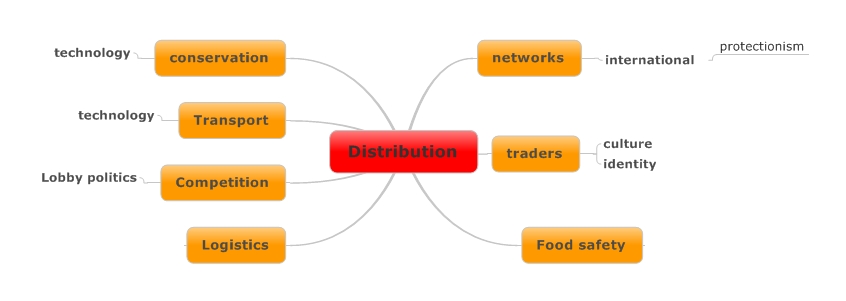The success of Kurlansky’s book goes further than the popularity of its protagonist. The book came heavily spiced with anecdotes and historical recipes. The chapter on the Founding Fathers is hilarious and the Cod Wars between
The great
thing about books on food is that they give a unique platform for storytelling.
Providing almost every possible angle on history and touching on many parts
that fire the imagination and interest.
I’ve put a
few of these angles in mind maps arranged about the three stages of the food
chain: production, distribution and consumption.
What is immediately apparent is that food is closely connected to culture and identity, from the peasants’ close connection to the soil, to the religious rules on which products you can eat. In some cases ethnic of social groups were closely tied to trade of certain products. Think of Jewish in the 19th century European cattle trade. However, their identity seemed to be more important in determining their trade than the other way around, as in the case of production and consumption.
The economy
of food is fundamental to any story. Almost all foods covered in these books are
tied to agriculture or horticulture. Fishing and hunting are less universal in
appeal and perhaps therefore not as popular as subjects (although the craze was
set off by cod). This evolves in first instance about the means of production
such as labour, land and capital.
Production
in certain places becomes based on certain types of labour, with far reaching long
term social consequences. The landed gentry and yeomen farmers of England were a major factor in its political
development, while slavery still casts a shadow over the Caribbean .
The high risks of the local climate and social restrictions prevented South
East Asian peasants from devoting more land to profitable export crops.
Production was also determined by land ownership and quality of the soil. The shift to cheese production in medieval
Trade seems
to be less of a subject in these books. Trade ties in to important questions
about international networks, transport and conservation technologies and
access to markets. In the 19th century it becomes linked to
cooperative production and export, chain retail and accessibility of products
to new groups of consumers.
The
specific location of production can determine distribution. The Dutch monopoly
on nutmeg was a vital element in trade and the profitability of the East India
Company, the first modern multinational (semi-)private enterprise.
But social subjects
are also in very much scope. Hunger, obesity and health are intimately related,
while most tropical products have a history of plantations and slavery or migration
and indentured labour. As such they are also related to imperialism.
Women’s and
men’s roles in food production, distribution and consumption are very
different. In some cultures men till the soil, while women focus on the smaller
animals nearer home, cheese production and selling products on the market. Anorexia
nervosa is an almost exclusively female condition, while masculinity is
stressed by eating red meat and spicy food.
A field
that I think is fascinating is the relationship between food and emotion. We
eat different foodstuffs at parties than when we’re in need of comfort. For
many people certain products have become closely identified with liberation
(chewing gum), freedom and progress.
Lately eating
healthy has become a quest for some (eg the boy who is only allowed to eat
uncooked food by his mother) which goes beyond the immediate health issues and
is now part of a broader health culture that takes on obesity, genetically
modified crops and professional health organisation. Is a glass of wine each
day good for longevity or not? What about garlick? And chocolate?
You can
probably come up with things I haven’t even touched on in these mind maps, so
feel free to come up with suggestions. Alternatively, you could help me coming
up with similar mind maps for military history.




Interesting topic indeed. I personally wonder if people always eat different food at parties than when they're comforting themselves. I could well imagine that it both involves fatty and sweet stuff.
ReplyDeleteAlso I think the current interest in food also involves environmental (the physical space needed to eventually have a steak on your plate, or food miles, for example) and animal wellbeing (free range eggs, biological pork, and so on) issues and some sort of need for authenticity. Think about the biological apples you may buy at your local greengrocer. Lately this involves the photo of the farmer who has grown these apples, whom, in my case, is more or less from the area I live in.
Hi Sippy,
ReplyDeleteGood points! Environmental impact is something to look at. Not only in the present, but also in the past as change from arable farming to dairy in the medieval Netherlands and early modern Denmark have been linked to salification and loss of top soil.
Animal well being seems a current preoccupation, just like questions of authenticity, which I would argue should be considered as developments on the consumption side.
Regarding the similarities of comfort and party foods, I think there is an overlap in fat and sweet stuff, but there are considerable differences in which they are presented. Party food is displayed and dressed up, while comfort food is eaten straight out of the bag. Also, champagne is not comfort food.